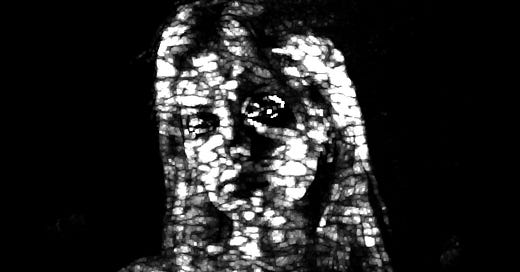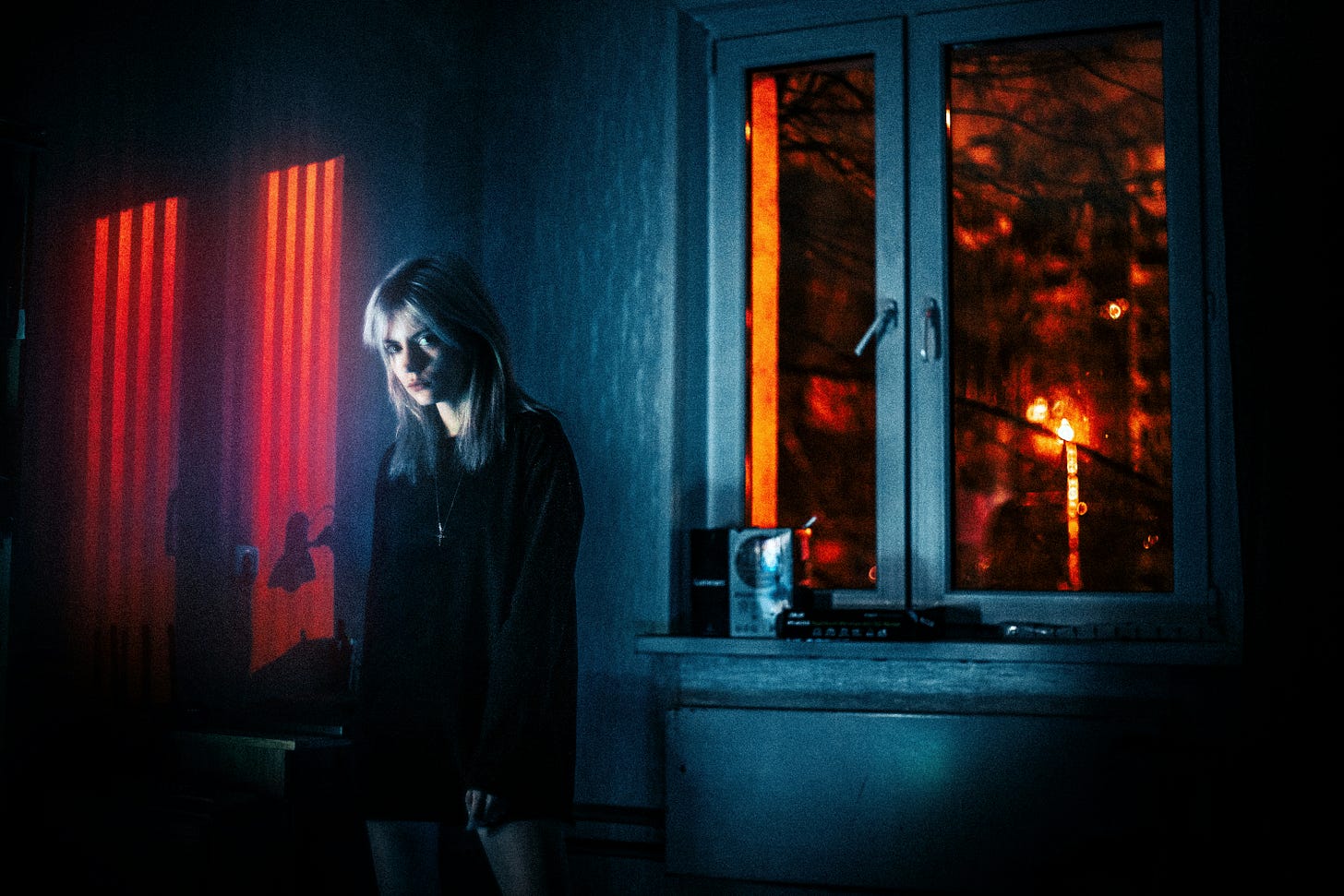Over six months into sobriety, I am haunted by nightmares. Nearly every single time I sleep, like clockwork, I am visited by revolting tales of gruesome construction. Common themes include torture, gore, creatures of terror, survival, drugs and grinning pale faces with carved-out, bulging eyes, staring into my hyperaware subconscious. The detail and realism characterizing these dreams is unnerving; many times I have woken to immense relief as I realized they were not my life. They often last for what feels like an abnormal amount of time—I watch without choice as complex, hellish stories of pure depravity unfold in vivid fashion. These figments of my psyche are deep dives into the realm of surrealism, composed of meticulous plotlines and an unforgettable cast of vengeful gremlins—perfect content for the ultimate horror film yet so far beyond anything I have ever watched.1
The experience of a deeply disturbing nightmare is fascinating. In fact, I am stricken with bewilderment as they continue to happen. The level of intricacy and the depth of evil depicted within them is incredible. They feature genuine, raw emotion—sensations of fear, arousal, disgust and utter hopelessness are all routinely felt. Contemplating the creation of these scenes, given the structure of my lived experience thus far and my imaginative capacities, I cannot help but wonder if there is some deeper, literal meaning behind them—perhaps a spiritual element, something yet to be understood by modern science. In this essay, I seek to outline possible ambiguities in relation to the spiritual complexion of dreaming—conjecture designed to illicit thought provocation and challenge extant paradigms.
Consider first the namesake of this platform—astral projection—the art of consciously leaving one’s body upon the cusp of entering what should have been a sleep-state, apparently into an infinite, otherwise-invisible macrocosm filled with non-physical entities and cosmic absurdities, known in spiritual circles as the astral field. In the past, I have managed to execute this act using ingestible substances, thus proving its validity, at least to myself. I do not condone or suggest trying this whatsoever, but for completeness my ritual was as follows: consume a stimulant less than an hour before launching, ranging from caffeine to amphetamines to cocaine, take my then-prescribed atypical sleeping pill, lemborexant, a drug similar in effect to ambien without the abuse potential, crawl into bed and allow the natural course of action to materialize. The combination of a potent hypnotic, which pulls one towards deep sleep, and a psychostimulant, contrasting this tendency, would result in the aforementioned phenomena known as astral projecting. A low rumble in my periphery, proceeded by visual agitation, would signal its initiation, and if I could surrender resistance just enough, my conscious frame would be jarringly discharged from my body into the surrounding room. I never managed to cross that boundary without being sucked back into my skull; regardless, it served well as a testament of potentiality.
I discovered this method purely by accident. Frankly, when it first began, it was horrifying. Reaching the point of total bodily dissociation would result in panic, causing my psychic reach to rescind and my physical form to shake violently back into wakefulness. Astral projection is not a new concept—there are massive online forums dedicated to spiritual explorers, individuals claiming to have mastered the exiting of their bodies who post wild stories of video game-like, fantastical adventures spent in this mysterious plane of being.2 There even exist full-scale online courses that teach those interested how to effectuate physical deportation along with an eclectic range of intriguing applications, such as: connections beyond space and time, conscious death and higher spiritual awareness.3
There is no real base of scientific evidence on the mechanistic workings of astral projecting; therefore, as alluded to, the majority of this article may be thought of as both speculation and a call-to-action for future researchers. With that made clear, multiple sources have conveyed to me that astral projection occurs every single time anyone falls asleep. Under this assumption, the differentiating factor that determines if one remains consciously in control is whether they can purposefully rip their minds out from the grasp of sleep immediately upon its descension.4
Although I have not yet had the fortune of lengthy ethereal travels, the nightmares I bear are reminiscent of how I would imagine gone-wrong astral projection sessions to feel like. The content is the most glaring clue—hallmarked by indescribable insanity, I struggle to attribute the composition of these dreams strictly to internal reinventions of my memorized history, despite its intrinsic darkness. They are inhuman, morbid, analogous to the cinematic bastard-child of David Lynch and Takashi Miike, amplified thousands-fold in terms of madness, violence and cruelty. In a twisted sense, I feel blessed to function as the vessel for their cognizant awareness and I am compelled to understand the true nature of their origins.5 I would love to exemplify this curious happening with depictions of specific dream scenarios; however, although I have considered trying to record and track them, their intense specificity and marked ultra-complexity make this rather difficult.6
In putting together an anecdotal, creative hypothesis on these matters, the assumed existence of the soul is required, which in this context represents the purest, truest form of self—a highly-intelligent spirit inhabiting a physical body. Due to the relatively short duration of my projected conscious state, I cannot conclusively answer whether I retained my “normal," societally-loaded mind while outside of my body. If certain extraneous layers are momentarily lost in transition, it would suggest that the soul acts as an astral vehicle, perhaps still intertwined with some fundamentally necessary components of “normal” consciousness that allow viewers to remain in familiar, 3-dimensional, Euclidean geometry.
Further, I would speculate that the soul, presumably being a sentient lifeform of magnitudes more complexity than the humans they implore, would need to tend with other problems whilst remaining in appropriate harmony with their physical containers. Intuitively, the “time” to perform higher-dimensional maintenance (assuming the concept of time as we experience it is relevant to the soul, which it very likely may not), would be during sleep. Astral projection is probably not a commonplace human behavior—it resembles more of a glitch in the system. Alternatively, using the videogame/simulation theory analogy, it could be construed as a cheat code or “easter egg,” a prize-like bonus meant to be unearthed by diligent users. In this light, astral travels could be envisioned as hijacking the spatial functioning of the soul, thus becoming able to traverse non-ordinary realities with ultra-speed, transcending standard limits of time and space.7
For the average person, sleep would signal to the soul that it may perform whatever parts of its agenda it must but cannot complete while its human is awake. Dreams would be comparable to the elevator music stores play while their customers are on hold, amusing, meaningful even, based on experience yet ultimately masking some behind-the-scenes, higher-level operations that the client is totally unaware of.8 Subsequently, the content of dreams could be relevant to or representative of whichever specific manifestations of the soul are underway. In particular cases, I would surmise that this normalized capacity of concealment is exceeded due to morphing of an operational boundary—the person is granted visual access to higher-level actualization of the soul in the form of metaphorical imagery.
Applying this theory, my perversely founded nightmares could be symbolic illustrations of some ominous undertakings of my soul. This could be an indirect consequence of a multi-year period of extreme psychedelic usage, compounded by other amplifying drugs such as stimulants and dissociatives, many of which were obscure research chemicals. Throughout that time I was convinced of a raging spiritual “war,” which, inside my perception, I became immersed within as I endured strange, unforgettable, dramatic occurrences of the spiritual, surreal variety—artifacts of oddity I am still working to unravel.9 I struggle in the disclosure of these subjects—although I can sense their validity, an ultimate purpose in their witnessing, the climate of societal rigidity leaves me uneasy at the prospect of deciphering their meaning publicly. However, were they to reach even a single person also grappling with something profound yet unexplainable, it would be well worth any discomfort gleamed from an open revelation.10
This hypothesis could definitely be way off-track; however, for the sake of entertainment and thoroughness, especially considering that spirituality will hopefully one day shape itself into a legitimate empirical field of inquiry, it is worthwhile to at least ponder the idea. For topics lacking a substantial means of rigorous analyses, baseline portraits of theoretical architecture are crucial in catalyzing the eventual discernment of useful regions of focus, in regards to data collection. In a society already fully-saturated (if not oversaturated) with research and debate within its well-established areas of study, clever inquisitive methodologies will prove themselves paramount in the next wave of epistemological advancement.
Perhaps, one aspect of my divine purpose lies in adventuring the bizarre facets of a spiritual reality this world does not yet know, such that they may become unearthed, understood and even utilized. Believing in the seemingly unreal is a ticket to isolation in our hyper-logical, by-the-book culture; however, I would rather seem outlandish in the present than to have my very real memories and subsequent interpretations become lost and obsolete in my death, rendered useless. To speak freely of one’s felt truth is always the integral route, even if it is ripe with frightening vulnerability and met with harsh opinion.
To develop an experimental study that probes unfamiliar modes of being, such as astral projecting, is highly desirable—a reliable means of testing and reworking blueprints of new-age spiritual ideology would be invigorating, both in a personal sense and as a community of knowledge-seekers. In an idealized scenario, a like-minded individual would emerge from the recesses of informational void-space to become a theoretical contender—someone unafraid of interpersonal ridicule with whom I could relay conceptual packets to and from.11
Regardless of the judgement of others, positive or negative, I possess my own perfectly valid set of experiential findings that I am able to expanding upon. I have an inherently strong level of trust in myself, largely due to the self-witnessed integrity of my personal disclosure and an awareness of obvious biases involved. I also have a firm resolve to attain further data through totally sober and legitimate means. That psychoactive drugs were sometimes (not always) involved in the gathering of such information does not cast them as rubbish; instead, this is merely a constituent of the experimental methods, something that would require recognition in the appropriate section of a journal paper. Some may argue otherwise, but I fiercely believe that the stream of conscious perception, whether augmented by chemicals or not, given by an authentically integral source—a purely honesty description of what was experienced and the relevant context—represents a useful referential point.
Non-ordinary realities have been of serious interest to many great minds throughout history; for example, Stanislav Grof, cult-famed Czech Slovakian psychiatrist, devoted a large portion of his career to studying the introspective journeys of patients under the influence of LSD. Evidently, he trusted these people to be reliable in their statements regarding inner experience. To bluntly discard one’s lived memory simply because of intoxication by psychotropic substances is archaic and ignorant. States of being similar to those induced by entheogenic drugs have been found attainable through alternative, non-drug-based techniques such as intensified holotropic breathwork (a concept introduced by Grof), something I also have personal experience with and a strong urge to further investigate. This suggests a commonality and, in essence, supports the validity of chemically-modulated states of consciousness.
The planes of existence reached in these novel states, whether through controlled usage of psychoactives, modified breathing methods or peculiar sleep-phenomena are well-worth the attention of modern science as they elucidate yet-hidden corners of the total sphere of reality. Analogous to explorers of frontier times are “psychonauts,” a term referring to those who bravely dive into the fabric of unnatural human consciousness in hopes of enlightening themselves and the world about the essential nature of worldly perception. There is much to be revealed—astral projection and abnormal dreaming are prime examples of the wonderous potential found in studying spirituality.
Thanks for reading! If you enjoyed this essay please consider supporting my work by sharing Astral Projections with a friend or loved one who may enjoy it. Also, feel free to reach out if there is a specific topic you would like to see covered.
I say this as a once-avid fan of disturbing and ultraviolent horror/snuff films.
For those curious, check out r/astralprojection which boasts over 300,000 subscribers.
I recall reading about an interesting social experiment as part of the linked course, where people are guided to astral project and “go” to the same “place,” reporting back information, without conferring in each other, that would otherwise not be possible.
Note that, although similar, astral projecting is different than lucid dreaming. In the latter, the person is in control of their dream states but has actually fallen asleep. In astral projecting, the person exits the control volume that is their body right before they should have fallen asleep.
To further this point, I have lived with what I would call “normal” nightmares, obvious manifestations of trauma, for a number of years, even through my addictions. Relative to the dreams I have now, these dreams were tame despite being disturbing in their own right. The ones in present day started very suddenly, like a switch had been flicked, a few weeks after I left inpatient treatment and continue to this day (almost) every single night. On the other hand, the trauma I experienced in the 2 months prior to treatment was extreme and condensed; thus, being wrong about a non-memory-based sources of such dreams would not surprise me. Regardless, I enjoy the act of deliberate conjecture.
I can usually remember singular snapshots of specific dreams rather than entire plotlines, along with the general essence of terror and thematic overlays which accompany them. For example, from the night prior to me writing this, I can vividly recall a scene in the perspective of a person underneath a dangling, grotesque, humanoid-like creature bearing an unnaturally wide grin and exploding, evil eyes, forcing me to slice a rectangle along its scaly flesh until its steaming guts dumped onto me, at which point I woke up.
This idea aligns with a musing put forth in the linked previous article, untitled simulation theory; namely, that our data is uploaded during sleep to the “hard-drives” of higher-dimensional beings, who are simulating us, for analyses and alterations to be completed. In the context given here, sleep is the designated period for the soul to perform actions it could not otherwise do when acting inside a wakeful human being. One could go further and combine these two theories, assigning the soul as the simulation engineer, at least in part, and the sleep-denoted operations to include data management.
There is definitely a better metaphor here, as the elevator-music of corporations masks relatively low-level actions compared to what I am envisioning dreams to be here.
The specifics of this theorized soul activity are something I am still fleshing out. I pushed the limits of observable human experience and bear spiritual scars now as a result. This was as far as I could take this theory, for now—it serves as groundwork for further investigation and speculation. Whether I truly believe that these dreams represent something beyond human imagination—I am ambivalent.
During my stay in an inpatient recovery center, I had the honor of working with indigenous leaders who allowed me to process some of my more enigmatic experiences in a compassionate, non-judgmental setting, which was highly cathartic; still, they rattle around my psyche, begging to be heard, neurological shackles with exaggerated weight. These healers labelled me as an “experiencer,” one who observes the unobservable, which resonates with me but is, again, not something I feel overly comfortable marketing publicly.
Also worth mentioning is the hive-mind that is Reddit, an intriguing network of diversified depiction, richly populated by open-source peculiarities. There is vast discussion of all sorts of esoteric topics on Reddit; however, to harvest such a platform for valid data would be to assume the strict honesty of its user-base. A falsified experience could subconsciously taint an otherwise integral theoretical derivation and therefore, I tend to refrain from even visiting such forums lately, even knowing that I would find a welcoming community. Unfortunately, denizens of the internet are hungry for virality, and this lulls people into thinking that they are allowed to shape some fake narrative and spread it, simply for the views and clicks.
Note: All photos used in this essay, including the cover art (which was altered by the author in Inkscape), are from the talented photographer Oleg Onchky on Unsplash. IG: @onchky










